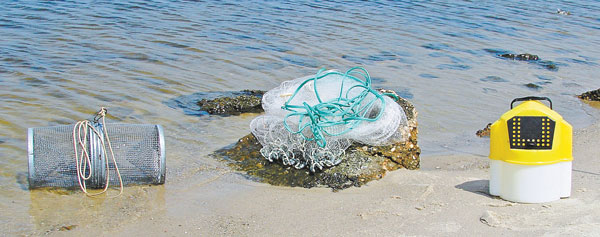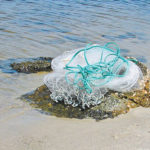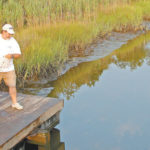
It amazes me sometimes when I talk to fishermen and suggest trying live bait for targeting a certain fish, and the response is, “I’d really like to, but there’s no where around here that sells it.”
As I get older, I am beginning to appreciate the convenience of occasionally buying live bait, but I really would rather catch my own. Think about it; for the tackle shop to have bait to sell, someone had to catch it. I understand worms, crickets and mud minnows are being farmed, but mullet minnows, shrimp, pinfish, sandfiddlers and everything else is caught and brought to the tackle shop to sell.
What you can catch and where you can catch it varies by location, but I’ll concentrate on the most folks can catch: minnows, small menhaden, shrimp, sandfiddlers and sand fleas. While there are some excellent bait dealers — I wouldn’t want to slight their baits — I just feel more productive using bait I caught myself. Confidence is a significant part of fishing and this is one place to gain some.
Be sure to understand several basic rules. A Coastal Recreational Fishing License (CRFL) is required to catch bait for personal use. All size and creel limits must be observed. A maximum of 200 mullet may be caught, and up to 100 shrimp person may be caught for bait, the latter by cast net only, in an area that is closed to shrimping.
Sand fleas live in the sand along the ocean beaches and are excellent baits for pompano, whiting (sea mullet) and other fish that feed in the surf. Several versions of sand flea scoops and rakes are available. You dig sand and then sift it through a wire basket.
The biggest mistake most people make is digging in a hard section of the beach. If it’s difficult for you to dig, it’s difficult for them to burrow, too. Walk down the beach at the water’s edge barefoot and when the sand feels noticeably softer, dig for sand fleas there. The surf in front of the spot you catch sand fleas is usually a good place to fish; the species that eat them know they are there, not a half mile up the beach where the bottom is hard-packed.
Sandfiddlers (fiddler crabs) are another excellent bait, but many fishermen consider them a pain in the butt to catch and handle. Sandfiddlers have one small and one large claw and can pinch severely with the large claw. These small crabs live in holes in the marsh and are excellent baits for sheepshead, red drum, black drum and other species.
Sandfiddlers can be caught using several methods. Some fishermen dig a hole and bury a bucket in the marsh, and then herd the sandfiddlers so they fall in the bucket. Some fishermen throw a cast net over them and then pick the small crabs out of the net. I use a crawfish trap, with boards to guide them to it, and they just crawl up the lip and into the trap. Herding them makes catching them faster. I have not found a bait for the trap that noticeably attracts them.
Mud minnows and some of their shallow-water cousins is best accomplished with a minnow trap that’s baited and lowered into the water. The deeper you locate the trap, the fewer mud minnows you typically catch. If you think about it, you usually see smaller minnows in the shallows and just below the surface. Place the trap in water shallow enough that part of it is exposed but deep enough that the entry holes are submerged. I don’t know why, but galvanized traps usually produce better than plastic or coated ones.
There are several ideas on the best bait for minnow traps. When I was a teenager, bread was considered the best, and it definitely caught minnows. I have experimented with a variety of natural baits including shrimp heads, crushed crabs, fish scraps and chopped up leftover baits. All of these worked, but they sometimes lured something you didn’t want, such as an eel, into the trap.
What I have started using is pieces of bio baits that are no longer usable. I keep the pouch to store them in and then use them to bait the trap. You have to store like baits with each other and not cross Gulp! with Blurp and Trigger-X and such, but just keep a bag handy to store the pieces. Gulp! is so potent, you can put a bag with the leftover juice in the trap and just punch a couple of holes in the bag so the scent oozes out and doesn’t dissipate too quickly.
Pinfish traps are also available. Many fishermen find pinfish to be excellent baits for a variety of species. The traps are baited like minnow traps and are placed in areas known to hold pinfish, like beneath a fish-cleaning table that’s rarely used.
It has become rare to see fishermen seining for bait, but it is effective. Seines are small nets that use mesh small enough that fish don’t gill; the nets are beached or swept up from the water to remove what has been caught. Minnow seines vary from about 10 to 30 feet long and will catch a variety of minnows, small fish and shrimp. Seines require some ingenuity — or two people — to be use effectively. One end can be on a pole that is driven into the ground so one person can encircle an area and then pull the seine to the beach.
Cast nets are the next option for catching bait and are probably the most popular method across the entire bait spectrum. They are used to catch shrimp, minnows, mullet, menhaden and more. Cast nets vary in size, mesh size and weight. In general, larger nets cover more water and have the potential to catch more bait per throw; smaller mesh catches smaller bait; larger mesh allows smaller baits to escape, and heavier nets sink faster. Unfortunately it isn’t quite this simple, but it is a good starting place. Cast nets sizes are measured from the ferrule in the center to the lead line and will open to twice their stated size, so a 6-foot cast net thrown perfectly will open to cover 12 feet of water.
For really small minnows, a few companies make quarter-inch mesh nets. Most folks use 3/8ths-inch mesh for shrimp, finger mullet and such. Nets in half-inch mesh are for baits that are a little larger and in shallow water. Nets with 5/8ths- and ¾-inch mesh nets are for menhaden and larger baits and sink faster with equal weight, so they work better in deeper water than the smaller mesh nets Some net companies also make a 1-inch mesh especially for large mullet.
Adding weight can help and hurt a cast net’s performance. It will help a net sink faster until it reaches the point where it pulls the net closed. At that point, the net may sink fast, but it can’t catch anything closed up. If making nets sink faster was as simple as adding weight, every net could be made in a small mesh and with extra weight to sink fast in deep water. Remember this when you select the net for the bait you want to catch.
Once you have a bunch of frisky freshly caught baits, put them in an appropriate baitwell so they stay active and will attract fish when put on a hook. Many fishermen feel freshly caught live baits will catch more and larger fish than other live or natural baits and will always outperform lures. Hopefully these tips will help you catch your own live bait. At that point, it’s up to you to use it to catch lots of big fish.
Good fishing.






Be the first to comment